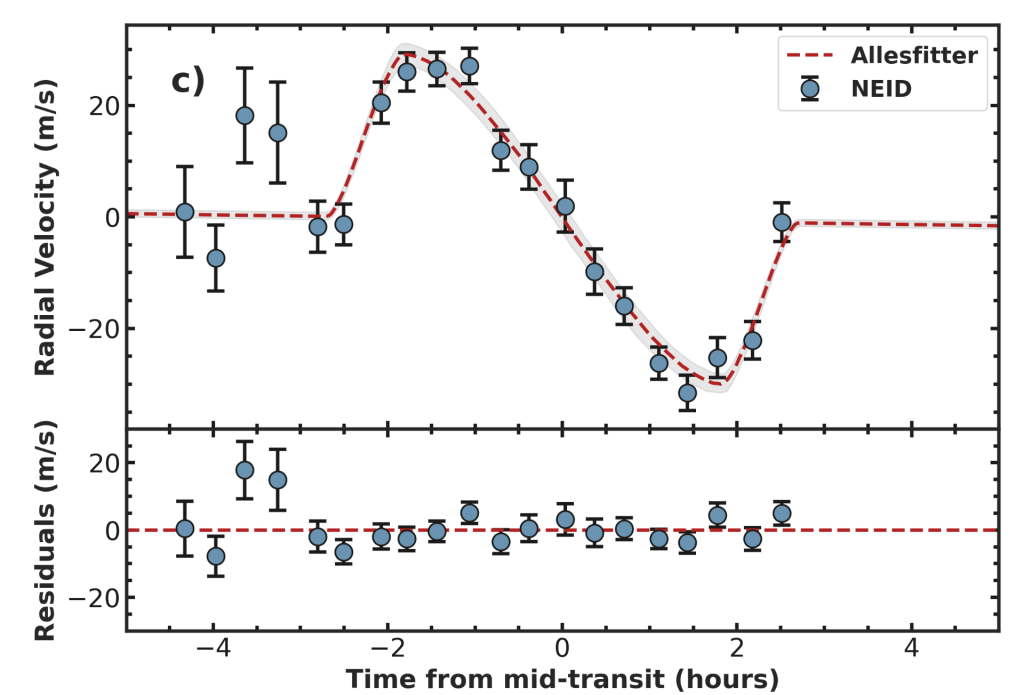Background
The TESS mission continues to discover fruitful exoplanet systems ripe for various types of detailed study, including with NEID. Recently, we investigated the spin-orbit angle of a planet in the TOI-1670 system. The NEID team has investigated this kind of question before with other systems. Check out this post on TOI-2076 for a great primer on what the spin-orbit angle is and how we measure it with the Rossiter-McLaughlin (RM) effect. In summary, we use the color of the light that a planet blocks as it passes in front of the host star to measure the path it takes across the face of the star from our perspective. This then allows us to determine if the orbital plane is nicely perpendicular to the stellar spin axis (aligned) or not (misaligned).
NEID Data
TOI-1670 hosts two known transiting planets: the inner, planet b, is a typical sub-Neptune on an 11 day orbital period; the outer, planet c, is a Warm Jupiter on a 40 day orbital period. This is an interesting architecture, as we haven’t found many systems with small planets interior to Warm Jupiters. This prompted us to wonder, are the planets in this system well-aligned to the host star’s spin axis?
To answer this question, we observed TOI-1670 on the night of April 19/20, 2023 from Kitt Peak National Observatory in Arizona. The night started out a little less than perfect; there were wispy clouds above, and so the first 4 observations we took have larger error bars due to capturing fewer photons within the standardized 7-minute exposure times. But then, just as the planet was about to transit, the clouds parted way and conditions were ideal! In total, we collected 21 spectra, 15 of which were during the transit of planet c.

The RM anomaly during transit of TOI-1670 c. NEID easily traces out the signal. The first 4 observations were taken through clouds and so they have larger error bars, but after these 4, conditions were ideal.
Using this data set, we determined that the 40-day orbital period Warm Jupiter, TOI-1670 c, is well aligned to its host star, finding the angle to be -0.3 +/- 2.2 degrees. This is a very tight constraint! The planet now joins 15 other Warm Jupiter planets (those with masses greater than 0.75 Jupiter masses and orbital periods longer than ~10 days) that are all found to be well aligned.
An Expected Result?
This is important because it puts the concept of alignment in a wider perspective. There is still much debate and uncertainty about how planets get into misaligned orbits. Leading theories mostly include dynamical interactions with other planets in the system and/or migration from the outer system to their current inner orbits. However, for misaligned planets that are very close in to their star, if they are massive enough (like Hot Jupiters), then they can actually realign their host stars to their new orbital plane through tidal interactions. Then, if we were to measure the spin-orbit angle, we would see an aligned orbit and would never know about the dynamical past of the system. However, for Warm Jupiters, because of their relatively wide separation from their host stars, they are not able to realign their star within the current lifetime of the Universe. So if we measure a misaligned orbit today, we can be sure there was some kind of dynamical history in the system. On the other hand, if we measure an aligned orbit, we can be almost sure that the planet formed in this aligned orbit and no realignment was needed.

Comparing TOI-1670 with similar systems across 2 dimensions. Left: all Warm Jupiter host stars with measured obliquities shows that those around single stars are all well-aligned, while the only misaligned planets orbit stars in binary systems. Right: all planets in multi-planet systems shows that nearly all multi-planet systems are well aligned, with a few notable exceptions.
That’s what we have in TOI-1670 c: an aligned planet that likely formed in a dynamically “cold” environment and retained its primordial alignment. In many ways, this was the expected result. TOI-1670 hosts a multi planet system, and the kinds of dynamical interactions that would produce a misaligned orbit are also likely to disrupt the system and possibly eject all but one planet. Since we have multiple planets here, it’s most likely that there was not these dynamical interactions between planets; that is to say, all planets played nicely together in the early days of this system.
While it is an expected result, it is still a fascinating one. And one that shows off the precise RVs that NEID is able to measure. More of these kinds of measurements are in NEID’s future, stay tuned!
Learn More
The full details of our study of TOI-1670 c can be found in a research article for The Astrophysical Journal Letters, led by NEID Team member Jack Lubin.
